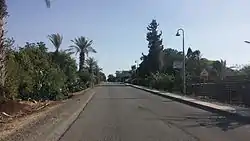Ramot, Golan Heights
Ramot (Hebrew: רָמוֹת, lit. "Heights") is a moshav and Israeli settlement near the eastern shores of the Sea of Galilee in the western Golan Heights. Named "Ramot" because it is located on two hills, it falls under the jurisdiction of Golan Regional Council. In 2019 it had a population of 552.[1]
Ramot
רָמוֹת | |
|---|---|
 | |
 Ramot | |
| Coordinates: 32°50′58″N 35°40′03″E | |
| District | Northern |
| Council | Golan |
| Region | Golan Heights |
| Affiliation | Moshavim Movement |
| Founded | 1969 |
| Population (2019)[1] | 552 |
| Name meaning | Heights |
The international community considers Israeli settlements in the Golan Heights illegal under international law, but the Israeli government disputes this.[2]
Geography
The community is located on a small hill, which is the lowest step on the slope that falls from the Golan Heights to the Sea of Galilee, about 10 meters (33 ft) below sea level (compared to the Sea of Galilee which is about 210 meters (690 ft) below sea level). The community is 2 kilometers (1.2 mi) east of the Sea of Galilee and 7 kilometers (4.3 mi) north of Ein Gev.
History
The moshav was founded in 1969, when Golan area was a part of the Israeli Military Governorate. In 1981, the area of Golan was unilaterally annexed by Israel, applying Israeli civil rule on the area. The founders first lived in the houses of the abandoned village of Skopye, and then settled two years later to temporary "triangle houses" in what is now the Ramot recreation village. In 1973, they resettled in the moshav's current location. The moshav is a member of the Moshavim Movement.
Population
As of 2012, the moshav had 478 residents.
Economy
The economy of the community is based on irrigated agriculture (bananas, mangos, lychee, palm trees, guava and avocado, and flowers), poultry production, raising cattle for meat and milk, and raising sheep.
References
- "Population in the Localities 2019" (XLS). Israel Central Bureau of Statistics. Retrieved 16 August 2020.
- "The Geneva Convention". BBC. 10 December 2009.
- "Archived copy". Archived from the original on 2013-04-14. Retrieved 2013-03-10.CS1 maint: archived copy as title (link)
.jpg.webp)